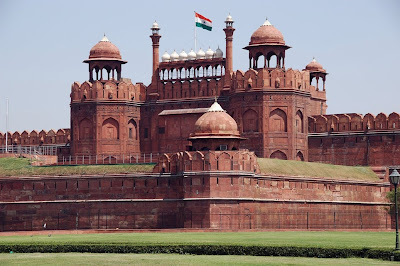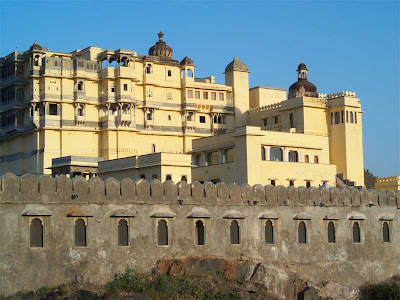This is the style that developed in the Dravida Desam. The Vimana and the Gopurams are the distictive characteristics of the Southern style. The Vimana is a tall pyramidal tower consisting of several progressively smaller storeys. This stands on a square base. The Gopuram has two storeys seperated by a horizontal moulding. The Prakara or the outer wall, envelops the main shrine as well as the other smaller shrines, the tank.
The Pallavas, the Cholas, the Pandyas, the Vijayanagar rulers, the Nayaks all contributed to the Southern style of temples.
Pallava Temples :
The Pallava shrines normally have a Somaskanda relief panel.
Some of the Pallava temples:
Rajasimha temple
Olakkanesvara temple Mukundanayanar temple Shore temple at Mamallapuram Talagiriswara temple at Panamalai in South Arcot Kailasanatha temple at Kanchipuram (Rajasimha & his son Mahendravarman) Vaikuntha Perumal temple by Nandivarman
Chola Temples
The Cholas erected several temples and also renovated earlier brick structures in stone.
Early Chola temples:
Sundaresvara temple at Tirukattalai (Aditya I) Vijayalaya Choleswaram at Narthamalai Komganatha temple at Srinivasanallur (Parantaka I) Brihadiswara temple at Tanjavur (Raja Raja Chola) Brihadiswara temple at Gangaikonda cholapuram (Rajendra Chola) Airavateswara temple at Darasuram (Raja Raja II) Kamaparharesvara temple at Tirubuvanam (Kulotunga III)
The Pandyas mostly concentrated on the Gopurams, the main entrance. The basic structure and style was maintained, but the decorations on the Gopurams and the size characterises the Pandya Gopurams.
The typical Pandya style can be seen in the
Sundara Pandya Gopuram added to the Jambukesvara temple
Eastern Gopuram, Great Temple, Chidambaram
The main contributions of the Vijayanagar period were the tall massive gopurams and the multiple mandapas. Unlike the Chola style, where the entire temple structure was usually a unified whole, there were numerous mandapas, pillared halls, shrines to minor deities, tanks, etc. Another major feature is the carved pillars - with the rearing simhas (lions), yalis (lions with elephant trunks).
The important temples from the Vijayanager period:
Vitthala Swami temple, Vijayanager
The pillars and gopurams of the Ekambaranatha temple .
Nayak Temples
The Madurai and Tanjavur Nayaks made great contributions - the main characterictics of this period being the elaborate mandapas of the hundred and thousand pillared type, the high gopurams with stucco statues on the surface, the long corridors.
The main temples representing this style in various portions are
The Ranganatha temple at Srirangam - for the increase in the no. of enclosures
The temple at Rameswaram - for the long corridors
The Subramanya temple at the Brihadisvara temple court at Tanjavur - for the fine vimana with ardha and maha mandapas.
![Reblog this post [with Zemanta]](https://lh3.googleusercontent.com/blogger_img_proxy/AEn0k_tdtHIt_KUDJhcbmdE8I3F1Y47r9TiAbetHTy1A7ekiocYwY6i5fakeXHTCsLlCxKrM5irhJLMiTjk18hc82YJJQqB7pyNjNWF9lyJRIHygaudTR6J7EPFwas5w3Y9eIfrOZcQDM47E29_b6QpHCNw6=s0-d)
The Pallavas, the Cholas, the Pandyas, the Vijayanagar rulers, the Nayaks all contributed to the Southern style of temples.
Pallava Temples :
The Pallava shrines normally have a Somaskanda relief panel.
Some of the Pallava temples:
Rajasimha temple
Olakkanesvara temple Mukundanayanar temple Shore temple at Mamallapuram Talagiriswara temple at Panamalai in South Arcot Kailasanatha temple at Kanchipuram (Rajasimha & his son Mahendravarman) Vaikuntha Perumal temple by Nandivarman
Chola Temples
The Cholas erected several temples and also renovated earlier brick structures in stone.
Early Chola temples:
Sundaresvara temple at Tirukattalai (Aditya I) Vijayalaya Choleswaram at Narthamalai Komganatha temple at Srinivasanallur (Parantaka I) Brihadiswara temple at Tanjavur (Raja Raja Chola) Brihadiswara temple at Gangaikonda cholapuram (Rajendra Chola) Airavateswara temple at Darasuram (Raja Raja II) Kamaparharesvara temple at Tirubuvanam (Kulotunga III)
The Pandyas mostly concentrated on the Gopurams, the main entrance. The basic structure and style was maintained, but the decorations on the Gopurams and the size characterises the Pandya Gopurams.
The typical Pandya style can be seen in the
Sundara Pandya Gopuram added to the Jambukesvara temple
Eastern Gopuram, Great Temple, Chidambaram
The main contributions of the Vijayanagar period were the tall massive gopurams and the multiple mandapas. Unlike the Chola style, where the entire temple structure was usually a unified whole, there were numerous mandapas, pillared halls, shrines to minor deities, tanks, etc. Another major feature is the carved pillars - with the rearing simhas (lions), yalis (lions with elephant trunks).
The important temples from the Vijayanager period:
Vitthala Swami temple, Vijayanager
The pillars and gopurams of the Ekambaranatha temple .
Nayak Temples
The Madurai and Tanjavur Nayaks made great contributions - the main characterictics of this period being the elaborate mandapas of the hundred and thousand pillared type, the high gopurams with stucco statues on the surface, the long corridors.
The main temples representing this style in various portions are
The Ranganatha temple at Srirangam - for the increase in the no. of enclosures
The temple at Rameswaram - for the long corridors
The Subramanya temple at the Brihadisvara temple court at Tanjavur - for the fine vimana with ardha and maha mandapas.





